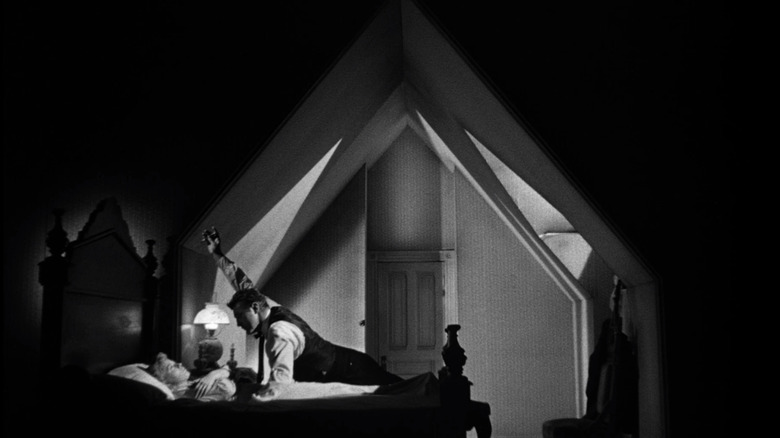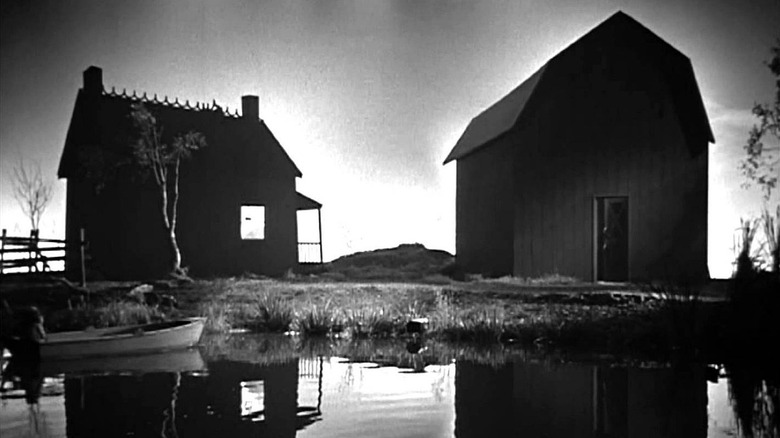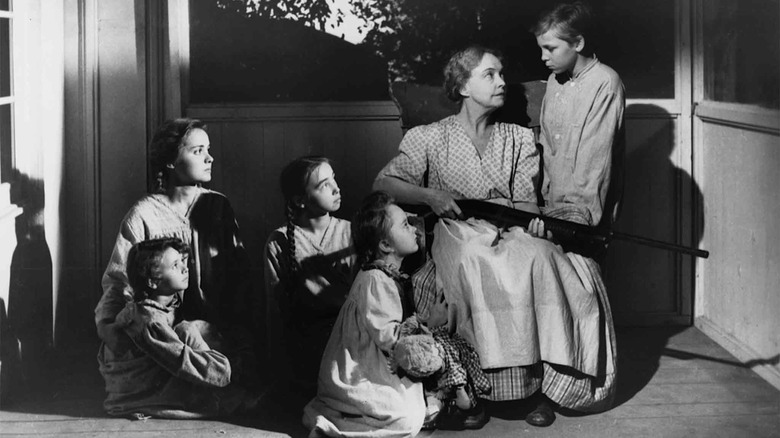How The Night Of The Hunter's Cinematographer Crafted Its Haunting Visual Style
The 1955 cult classic horror "The Night of the Hunter" may be one of the scariest films of all time, but not because of a well-timed jump-scare or dazzling practical effects. What is it that makes Charles Laughton's sole directorial credit so very terrifying? Robert Mitchum's performance as a Bible-thumping villain is enough to set your teeth on edge, but it's the haunting set design and Hilyard M. Brown and skillful camera work by Stanley Cortez that have always struck me to my core.
"The Night of the Hunter" was filmed at the tail end of Hollywood's golden era. Most of the major studios were running out of money in the mid-50s and early '60s, and there are tell-tale signs of budget cuts in a lot of films, a sort of canned quality. Cut costs meant that studios were forcing directors to put their huge sound stages to use rather than shooting on location, as Paramount did to John Ford in the production of "The Man Who Shot Liberty Valance" (via The Man Behind the Myth). Outdoor scenes were shot inside and everything, especially landscapes, had an artificial texture.
These sound stage sets gave "The Night of the Hunter" a deeply disconcerting feel. In a horror film where the audience's surrogate is a pair of children, this uncanny effect works to the film's advantage. The children's world is turned upside down when a religious man hears that their father robbed a bank and hid the fortune before dying. He seduces their widowed mother into marriage and tries to scare the kids into revealing where their father hid the money. The familiar — their home and their mother — is made unfamiliar to them, which is Freud's original definition of the uncanny. "The Night of the Hunter" is uncanny on every level.
Cortez leaned into uncanny
The set of "The Night of the Hunter" was built by Hilyard Brown, who also designed the sets for "Cleopatra" and "Creature from the Black Lagoon." "Now we had certain sequences down the river with the children and Hilyard Brown did a hell of a job for us in the building of the river and the houses of Stage 15 at Pathe," cinematographer Stanley Cortez recalled in an interview with American Cinematographer. He recognized how strange the man-made landscape looked on film. "The only way to get some points over was to stylize it," he explained. "The skies were all lit artificially and though it was in black-and-white it had a strange phosphorescent quality in it."
Rather than be upset by the unnatural quality of the set on film, Cortez chose to lean into it. "Before the picture started, I made tests with Tri-X film to see what the film would do not only from a speed standpoint but from a dramatic point of view, which to me is more important," he went on. "The technique is one thing and the dramatic concept is something else. In my book, the dramatic aspect is far more important, because through the dramatic concept the communication is made to the audience and this is the crux of the whole thing."
The use of Tri-X elevated the uncanniness of "Night of the Hunter." This made the artificial texture of the set feel intentional, rather than a budget restriction. Cortez lets the viewer know that they are not being asked to suspend their disbelief. In the words of Harry Styles, the movie "feels like a movie" (via Fred Film Radio).
Some scenes called for an extra dramatic look
Cortez wanted some scenes in "The Night of the Hunter" to be more theatrical than others, and it shows. "I used Tri-X on certain sequences, but not throughout the entire picture, not for the speed value but for the dramatic value," he explained. "By that I mean the blacks. They had the luminous, phosphorescent light I wanted in certain sequences. Tri-X was used in the house where the children lived, with the little stairway going up the left side, and in two other sequences."
The cinematographer chose to make the children's home one of the most dramatic-looking places in the film. Their most familiar setting to the children is made to look almost cartoonish and completely unreal. This deep blackness that Cortez speaks to also accentuates the shadows, which the cinematographer uses expertly to cultivate suspense.
"Night of the Hunter" was a box office flop with lukewarm critical reception, per Talkhouse, but it has since become a cult classic. The unforgettable cinematography and set design made the film an eerie time capsule into the dying studio era. It is a lesson in kitsch, a bible for the American uncanny, and it will freak you out in ways you didn't know existed.


